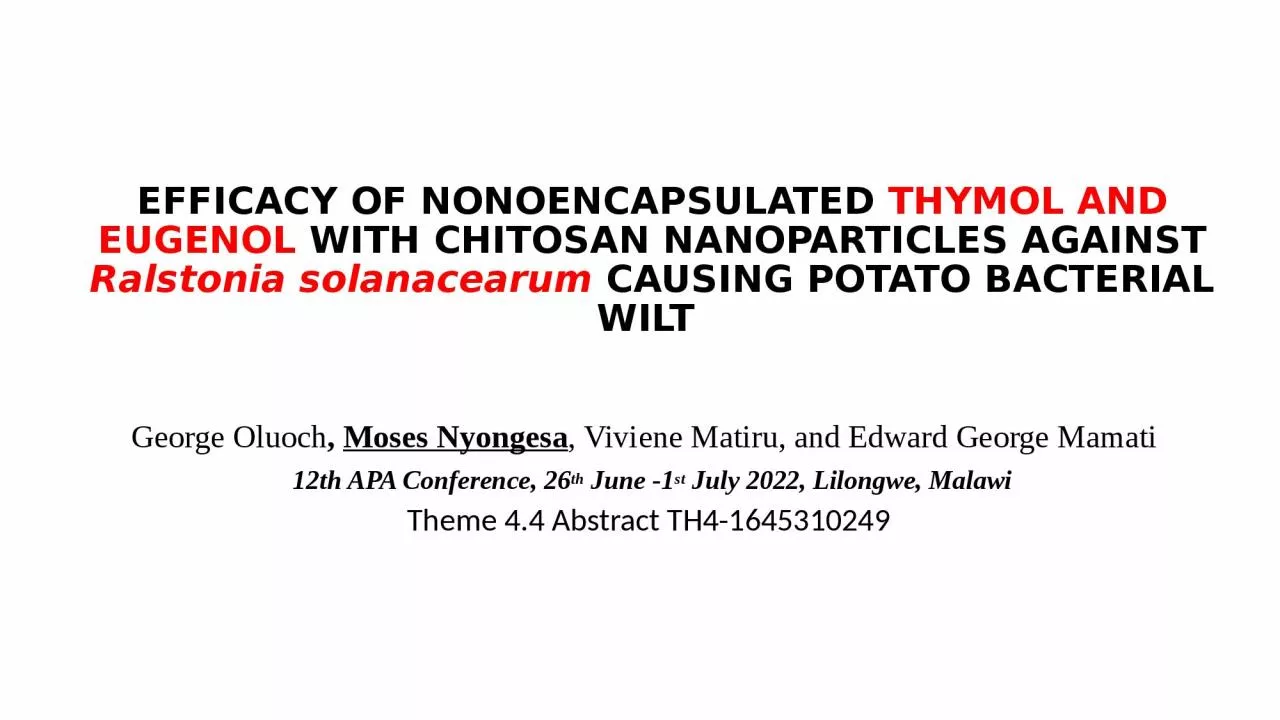

THYMOL AND EUGENOL WITH CHITOSAN NANOPARTICLES AGAINST Ralstonia solanacearum CAUSING POTATO BACTERIAL WILT George Oluoch Moses Nyongesa Viviene Matiru and Edward George Mamati ID: 1044033
Download Presentation The PPT/PDF document "EFFICACY OF NONOENCAPSULATED" is the property of its rightful owner. Permission is granted to download and print the materials on this web site for personal, non-commercial use only, and to display it on your personal computer provided you do not modify the materials and that you retain all copyright notices contained in the materials. By downloading content from our website, you accept the terms of this agreement.
1. EFFICACY OF NONOENCAPSULATED THYMOL AND EUGENOL WITH CHITOSAN NANOPARTICLES AGAINST Ralstonia solanacearum CAUSING POTATO BACTERIAL WILT George Oluoch, Moses Nyongesa, Viviene Matiru, and Edward George Mamati 12th APA Conference, 26th June -1st July 2022, Lilongwe, MalawiTheme 4.4 Abstract TH4-1645310249
2. R. solanacearum affects about 1.7 million hectares of potatoes in more than 80 countries worldwide leading to yield losses of between 33 to 90% in potato and up to $1 billion yearly in lost revenueIn Kenya it affects over 70% of potato farms and cause yield losses of between 50% to 100%.The current management strategies have limited efficacy and bacterial wilt continues to be an economically important problem for farmersThymol and eugenol are potential antibacterials against R. solanacearum and hence can be used for the development of novel bactericide against bacterial wiltTheir hydrophobicity and instability when exposed to the environment hampers their effectives and this can be addressed via nano-encapsulationIntroduction
3. Management of Bacterial wilt
4. In agriculture, nanotechnology is being explored in plant hormone delivery, transfer of target genes, nanobarcoding, nanosensors, and controlled release of agrichemicals
5. To evaluate the efficacy of antibacterial potential of thymol and eugenol coated with chitosan nanoparticles (TCNPs and ECNPs) against Ralstonia solanacearumStudy Objective
6. Isolation and identification of R. solanacearumVirulent isolateAvirulent isolateProfile of R. solanacearum isolation on TZC medium (E); Zoomed section showing virulent and avirulent colonies (F). EFVirulent R. solanacearum colonies (fluidal and pinkish red centers and whitish periphery).Avirulent colonies (small, round, non-fluidal butyrous colonies which are entirely deep red) Symptoms of bacterial wilt (A), Vascular browning from bacterial wilt infected tuber (B), Bacterial streaming test (C) and samples in collection bags (D).
7. DNA was extracted using Quick-DNA Fungal/Bacterial Miniprep kit from CPG grown R. solanacearum according to the manufacturer’s instructions. Virulent R. solanacearum on CPG medium (A), DNA isolated from the presumptive R. solanacearum isolates 1-4; L-1kb plus DNA ladder (B), Validation of R. solanacearum species complex using RsSC-F and RsSC-R primers; L-100 bp DNA ladder, 1-4 bacterial isolates, N-negative control (C), R. solanacearum species validation for isolates 1-5 with Nmult21:2F/Nmult22:RR primer pair; L-1kb plus DNA ladder; N-Negative control (D)Molecular identification of R. solanacearum
8. Pathogenicity tests of isolate of Ralstonia solanacearum three and four-weeks post inoculation. Left: Wilting and plant death symptoms induced in potatoes (cv. Shangi) by R. solanacearum isolate; Right, no visible symptoms (control with water). Pathogenicity test
9. Antibacterial activities of thymol and eugenol (100 μg/mL; 10 μg/disk) against R. solanacearum. Negative control (disc impregnated with DMSO), positive control (gentamycin disc (10 μg/disk). Zone of inhibition exhibited by thymol and eugenol (100 μg/mL; 10 μL/disk) against R. solanacearum. Error bars indicate standard errors of mean(n = 3).Antibacterial activity
10. Was performed using two step i.e. oil-in-water emulsion and ionic gelation method as described previously (Shetta, 2019).Schematic illustrations of EO encapsulation using a two-step process.Encapsulation process
11. Preparation of nanoparticles Preparation of nanoparticles; Chitosan solution Centrifuged nanoparticles and freeze dried nanoparticles
12. SEM image of TCNP (A), its zoomed image (C) and particle size distribution(D); SEM image of ECNP (X), its zoomed image (Y) and particle size distribution (Z).SEM images of TCNP and ECNP
13. Figure 1.6: Minimum inhibitory concentration of thymol (A) and eugenol (B) against R. solanacearum using resazurin aided microdilution; negative control (broth only); positive control (broth + R. solanacearum). 1.5 Minimum inhibitory concentration MIC for Thymol and Eugenol
14. Comparison of MIC’s of encapsulated and non-encapsulated Eugenol and Thymol Minimum inhibition concentration (MIC) of thymol, eugenol, TCNP and ECNP against R. solanacearum. The error bars indicate standard deviations with statistical significance (p < 0.05).Minimum inhibitory concentration of thymol (A) and eugenol (B) against R. solanacearum using resazurin aided microdilution; negative control (broth only); positive control (broth + R. solanacearum). BeforeAfter
15. Thymol and eugenol were successfully encapsulated in CNP as confirmed by UV-vis, FTIR and SEMThe loading capacity for TCNP and ECNP were determined as 81.5% and 79.7% while their encapsulation efficiency were determined as 54% and 55% respectively.TCNP and ECNP inhibited the growth of R. solanacearum with up to 92 and 94% respectively.The MIC of thymol reduced from 175 to 22.5 µg/mL after encapsulation with CNPs while The MIC of eugenol reduced from 275 to 45 µg/mL after encapsulation with CNPs while Key Findings
16.